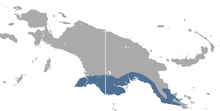
Tree-kangaroos are marsupials of the genus Dendrolagus, adapted for arboreal locomotion. They inhabit the tropical rainforests of New Guinea and far northeastern Queensland, along with some of the islands in the region. All tree-kangaroos are considered threatened due to hunting and habitat destruction. They are the only true arboreal macropods.
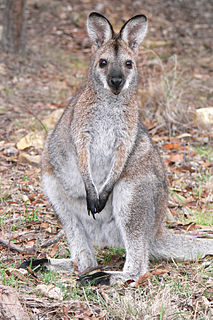
Macropodidae is a family of marsupials that includes kangaroos, wallabies, tree-kangaroos, wallaroos, pademelons, quokkas, and several other groups. These genera are allied to the suborder Macropodiformes, containing other macropods, and are native to the Australian continent, New Guinea and nearby islands.

The African palm civet, also known as the two-spotted palm civet, is a small feliform mammal widely distributed in sub-Saharan Africa. It is listed as Least Concern on the IUCN Red List.

The Japanese hare is a species of hare endemic to Japan. In Japanese, it is called the Nousagi, meaning "field rabbit".

The ruddy mongoose is a mongoose species native to hill forests in India and Sri Lanka.
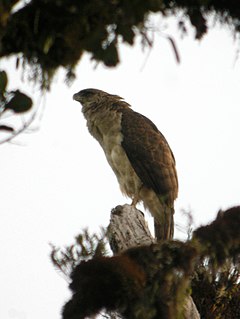
The Papuan eagle is a large bird of prey. It is also known by several other names, including Papuan harpy eagle, New Guinea eagle, New Guinea harpy eagle, or kapul eagle, the latter name from the local name for a usually arboreal, marsupial that the eagle is known to regularly hunt. This is an endemic species to New Guinea, and it can occasionally be found throughout the island. This is a forest-dwelling species, usually occurring in mature rainforest. The Papuan eagle is a fairly little-known species for a large eagle; however, it is known to prey on a wide range of prey, probably by and large mammals and birds from small to quite large sizes. What little study has been conducted about their breeding habits suggests they nest in a large forest tree, perhaps every other year. The Papuan eagle is probably naturally scarce, but it is under the threat of habitat destruction by deforestation, as well as hunting. Due to its small and declining population, the species has been classified as vulnerable by the IUCN.
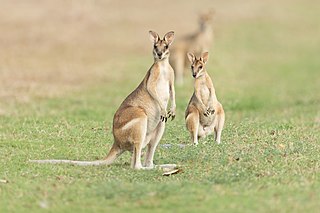
The agile wallaby, also known as the sandy wallaby, is a species of wallaby found in northern Australia and southern New Guinea. It is the most common wallaby in north Australia. The agile wallaby is a sandy colour, becoming paler below. It is sometimes solitary and at other times sociable and grazes on grasses and other plants. The agile wallaby is not considered threatened.

Doria's tree-kangaroo is a long-tailed, furry, bear-like mammal found only in tropical mountain forests on the island of New Guinea. It is one of the largest tree-kangaroos, living alone in trees and active at night to feed on leaves or fruit. It belongs to the macropod family (Macropodidae) with kangaroos, and carries its young in a pouch like other marsupials. Threats include hunting and habitat loss.

The grizzled tree-kangaroo is a furry, long-tailed, bear-like mammal native to tropical rainforests on the island of New Guinea. Like most tree-kangaroos, it lives in trees and eats leaves, fruit, and bark. It is a member of the macropod family Macropodidae with kangaroos, and carries its young in a pouch like other marsupials. The tree-kangaroo is uncommon and threatened by hunting and habitat loss. It is found in foothill forests of northern and western New Guinea and is indigenous to some of the offshore islands.

The tenkile, also known as Scott's tree-kangaroo, is a species of tree-kangaroo in the family Macropodidae. It is endemic to a very small area of the Torricelli Mountains of Papua New Guinea. Its natural habitat is subtropical or tropical dry forests. It is threatened by habitat loss and by hunting. The tenkile is listed as endangered due to hunting and logging activities in Papua New Guinea. The tenkile is hunted for its meat, and is the main protein source for the residents of Papua New Guinea. The population of Papua New Guinea has increased in recent years due to improvements in healthcare; therefore increasing need in tenkile meat which means that more tenkiles are being hunted. Additionally, tenkiles are poached for their fur and are captured and sold as a part of the illegal pet trade. Domesticated dogs also hunt tenkiles. Deforestation in Papua New Guinea affects all tree-kangaroos, however industrial logging that occurs in the Torricelli Mountain Range decreases the species' already restricted habitat. The Torricelli Mountain Range faces additional deforestation due to the timber industry, and the production of coffee, rice and wheat.

The lowlands tree-kangaroo, also spelt "lowland," is a long-tailed, furry, bear-like mammal found only in lowland tropical rainforests on the island of New Guinea. It is a species of tree-kangaroo, which are tree-dwelling animals that feed on leaves or other plant matter. Tree-kangaroos are in the macropod family (Macropodidae) with kangaroos, and like other marsupials they carry their young in a pouch. The lowlands tree-kangaroo is threatened by habitat loss.

The ursine tree-kangaroo is a long-tailed, furry, bear-like mammal found only in tropical forests on the island of New Guinea. Slightly larger than a cat, it lives alone in trees and is active at night to feed on leaves and fruit. It belongs to the macropod family (Macropodidae) with kangaroos, and carries its young in a pouch like other marsupials. It has a small range in northwestern New Guinea and is threatened by habitat loss and hunting. Other common names for this species include the black tree-kangaroo, the Vogelkop tree-kangaroo and the white-throated tree-kangaroo.

The black dorcopsis or black forest wallaby is a species of marsupial in the family Macropodidae. It is endemic to an island at the eastern end of New Guinea where its natural habitat is subtropical or tropical dry forests. It is threatened by habitat loss and hunting, its population is declining and the IUCN lists it as being "Critically endangered".

The white-striped dorcopsis or greater forest wallaby is a species of marsupial in the family Macropodidae. It is found in the northern part of West Papua, Indonesia and Papua New Guinea. It is a common species in suitable tropical forest habitat and the IUCN lists its conservation status as being of "Least concern".

The brown dorcopsis, also known as the brown forest wallaby, is a species of marsupial in the family Macropodidae. It is endemic to the lowlands of West New Guinea and the nearby Indonesian islands in West Papua of Misool, Salawati, and Yapen.
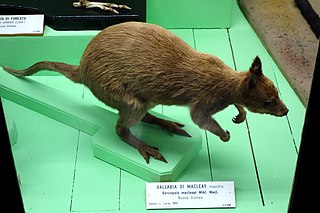
Macleay's dorcopsis, also known as the Papuan dorcopsis or the Papuan forest wallaby, is a species of marsupial in the family Macropodidae. It is endemic to Papua New Guinea, where its natural habitat is subtropical or tropical dry forest]. Being little threatened by habitat destruction, the International Union for Conservation of Nature has rated it as being of "least concern".

The small dorcopsis or lesser forest wallaby is a species of marsupial in the family Macropodidae. It is found in the mountainous interior of West Papua and Papua New Guinea. Its natural habitat is subtropical or tropical dry forests. It is less common than it used to be and the IUCN has assessed it as being "near threatened".

Calaby's pademelon, also known as the alpine wallaby, is a species of marsupial in the family Macropodidae. It is endemic to Papua New Guinea. It is threatened by habitat loss and hunting.

The collared mangabey, also called red-capped mangabey and white-collared mangabey is a species of primate in the family Cercopithecidae of Old World monkeys. It formerly included the sooty mangabey as a subspecies. As presently defined, the collared mangabey is monotypic.

The northern plains gray langur, also known as the sacred langur, Bengal sacred langur and Hanuman langur, is a species of primate in the family Cercopithecidae.

